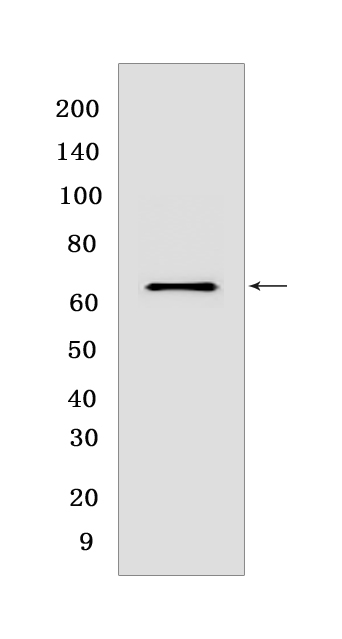CARD9 Rabbit pAbCat NO.: A63185
Western blot(SDS PAGE) analysis of extracts from Raw 264.7 cells.Using CARD9Rabbit pAb at dilution of 1:1000 incubated at 4℃ over night.
Product information
Protein names :CARD9,CARD9_HUMAN,Caspase recruitment domain-containing protein 9
UniProtID :Q9H257
MASS(da) :62,241
MW(kDa) :64 kDa
Form :Liquid
Purification :peptide affinity chromatography
Host :Rabbit
Isotype :IgG
sensitivity :Endogenous
Reactivity :Mouse
- ApplicationDilution
- 免疫印迹(WB)1:1000-2000
- The optimal dilutions should be determined by the end user
Specificity :Antibody is produced by immunizing animals with a synthetic peptide at the sequence of Mouse CARD9
Storage :Antibody store in 10 mM PBS, 0.5mg/ml BSA, 50% glycerol. Shipped at 4°C. Store at-20°C or -80°C. Products are valid for one natural year of receipt.Avoid repeated freeze / thaw cycles.
WB Positive detected :Raw 264.7 cells
Function : Adapter protein that plays a key role in innate immune response against fungi by forming signaling complexes downstream of C-type lectin receptors (PubMed:26961233, PubMed:33558980). CARD9-mediated signals are essential for antifungal immunity against a subset of fungi from the phylum Ascomycota (PubMed:24231284, PubMed:25702837, PubMed:25057046, PubMed:26679537, PubMed:26961233, PubMed:26521038, PubMed:27777981, PubMed:29080677, PubMed:33558980). Transduces signals in myeloid cells downstream of C-type lectin receptors CLEC7A (dectin-1), CLEC6A (dectin-2) and CLEC4E (Mincle), which detect pathogen-associated molecular pattern metabolites (PAMPs), such as fungal carbohydrates, and trigger CARD9 activation (By similarity). Upon activation, CARD9 homooligomerizes to form a nucleating helical template that recruits BCL10 via CARD-CARD interaction, thereby promoting polymerization of BCL10 and subsequent recruitment of MALT1: this leads to activation of NF-kappa-B and MAP kinase p38 (MAPK11, MAPK12, MAPK13 and/or MAPK14) pathways which stimulate expression of genes encoding pro-inflammatory cytokines and chemokines (PubMed:11053425, PubMed:26488816, PubMed:31296852, PubMed:26961233, PubMed:33558980). CARD9 signaling in antigen-presenting cells links innate sensing of fungi to the activation of adaptive immunity and provides a cytokine milieu that induces the development and subsequent of interleukin 17-producing T helper (Th17) cells (PubMed:24231284). Also involved in activation of myeloid cells via classical ITAM-associated receptors and TLR: required for TLR-mediated activation of MAPK, while it is not required for TLR-induced activation of NF-kappa-B (By similarity). CARD9 can also be engaged independently of BCL10: forms a complex with RASGRF1 downstream of C-type lectin receptors, which recruits and activates HRAS, leading to ERK activation and the production of cytokines (By similarity). Acts as an important regulator of the intestinal commensal fungi (mycobiota) component of the gut microbiota (PubMed:33548172). Plays an essential role in antifungal immunity against dissemination of gut fungi: acts by promoting induction of antifungal IgG antibodies response in CX3CR1(+) macrophages to confer protection against disseminated C.albicans or C.auris infection (PubMed:33548172). Also mediates immunity against other pathogens, such as certain bacteria, viruses and parasites,CARD9 signaling is however redundant with other innate immune responses (By similarity). In response to L.monocytogenes infection, required for the production of inflammatory cytokines activated by intracellular peptidoglycan: acts by connecting NOD2 recognition of peptidoglycan to downstream activation of MAP kinases (MAPK) without activating NF-kappa-B (By similarity)..
Tissue specificity :Expression is restricted to several populations of phagocytes, such as macrophages, monocytes, and dendritic cells (PubMed:33548172). Highly expressed in spleen (PubMed:11053425). Also detected in liver, placenta, lung, peripheral blood leukocytes and in brain (PubMed:11053425)..
Subcellular locationi :Cytoplasm.
IMPORTANT: For western blots, incubate membrane with diluted primary antibody in 1% w/v BSA, 1X TBST at 4°C overnight.


